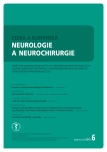Autoimmune Encephalitis – Case Reports
Authors:
V. Jakubčiaková; J. Slonková
Authors‘ workplace:
Neurologická klinika LF OU a FN Ostrava
Published in:
Cesk Slov Neurol N 2016; 79/112(6): 707-714
Category:
Case Report
doi:
https://doi.org/10.14735/amcsnn2016707
Overview
Introduction:
Autoimmune encephalitis is a heterogeneous group of neurological diseases manifested by acute onset of epileptic seizures, cognitive impairment, memory dysfunction or psychiatric symptoms due to inflammation of limbic (or extralimbic) structures mediated by autoimmune antibodies. The anti-NMDAr encephalitis, characterized by symptoms of diffuse cortical structures impairment, differs clinically from this etiopathogenicly heterogenous entity. According to its association with neoplasm, we can distinguish paraneoplastic and non-paraneoplastic LE.
Methodology:
We retrospectively analysed patient records and identified five cases suspected of autoimmune encephalitis.
Conclusion and discussion:
Patients with an acute onset of epileptic seizures accompanied by cognitive impairment and psychiatric symptoms should undergo neurological assessment, EEG, lumbar puncture including detection of antibodies against intracellular antigens (onconeural paraneoplastic antibodies), detection of antibodies against membrane and synaptic antigens and magnetic resonance of the brain. Immunotherapy should be started immediately when non-paraneoplastic limbic encephalitis is considered. Negative findings in cerebrospinal fluid do not exclude autoimmune brain inflammation. In paraneoplastic limbic encephalitis, surgical and anticancer therapy is the first-line treatment. Onset of secondary epilepsy cannot be excluded after a series of acute symptomatic seizures. Cooperation of neurologists, infectionists and psychiatrists is essential.
Key words:
autoimmune diseases – autoantibodies – encephalitis – paraneoplastic syndromes – epilepsy – limbic encephalitis – NMDAr encephalitis
The authors declare they have no potential conflicts of interest concerning drugs, products, or services used in the study.
The Editorial Board declares that the manuscript met the ICMJE “uniform requirements” for biomedical papers.
Sources
1. Brierley JB, Corsellis JA, Hierons R, et al. Subacute encephalitis of later adult life mainly affecting the limbic areas. Brain 1960;83:357– 68.
2. Krýsl D, Marušič P. Autoimunitní limbické encefalitidy. Neurol Praxi 2012;13(3):160– 4.
3. Vincent A, Bien CG, Irani SR, et al. Autoantibodies associated with diseases of the CNS: new developments and future challenges. Lancet Neurol 2011;10(8):759– 72. doi: 10.1016/ S1474-4422(11)70096-5.
4. Anderson NE, Barber PA. Limbic encephalitis – a review. J Clin Neurosci 2008;15(9):961– 71. doi: 10.1016/ j.jocn.2007.12.003.
5. Bien CG, Elger CE. Limbic encephalitis: a cause of temporal lobe epilepsy with onset in adult life. Epilepsy Behav 2007;10(4):529– 38.
6. Gultekin SH, Rosenfeld MR, Voltz R, et al. Paraneoplastic limbic encephalitis: neurological symptoms, immunological findings and tumour association in 50 patients. Brain 2000;123(7):1481– 94.
7. Lawn ND, Westmoreland BF, Kiely MJ, et al. Clinical, magnetic resonance imaging, and electroencephalographic findings in paraneoplastic limbic encephalitis. Mayo Clin Proc 2003;78(11):1363– 8.
8. Lancaster E, Lai M, Peng X, et al. Antibodies to the GABAB receptor in limbic encephalitis with seizures: case series and characterisation of the antigen. Lancet Neurol 2010;9(1):67– 76.
9. Paterson RW, Zandi MS, Armstrong R, et al. Clinical relevance of positive voltage-gated potassium channel (VGKC)-complex antibodies: experience from a tertiary referral centre. J Neurol Neurosurg Psychiatry 2014;85(6):625– 30. doi: 10.1016/ S1474-4422(09)70324-2.
10. Vincent A, Buckley C, Schott JM, et al. Potassium channel antobody-associated encephalopathy: a potentially immunotheraphy-responsive form of limbic encephalitis. Brain 2004;127(3):701– 12.
11. Wandinger KP, Saschenbrecker S, Stoecker W, et al. Anti-NMDA-receptor encephalitis: a severe, multistage, treatable disorder presenting with psychosis. J Neuroimmunol 2011;231(1– 2):86– 91. doi: 10.1016/ j.jneuroim.2010.09.012.
12. Hirsch LJ, Schmitt SE, Friedman D, et al. Extreme delta brush: a unique EEG pattern in adults with anti-NMDA receptor encephalitis. Neurology 2012;79(11):1094– 100. doi: 10.1212/ WNL.0b013e3182698cd8.
13. Psimaras D, Carpentier AF, Rossi C. Cerebrospinal fluid study in paraneoplastic syndromes. J Neurol Neurosurg Psychiatry 2010;81(1):42– 5. doi: 10.1136/ jnnp.2008.159483.
14. Stourac P, Kadanka Z, Palyza V. Paraneoplastic neurological syndromes – patient’s cohort profile in Czech Republic. Acta Neurol Scand 2001;104(2):72– 7.
15. Krýsl D, Elišák M. Autoimunitní encefalitidy. Cesk Slov Neurol N 2015;78/ 111(1):7– 23. doi: 10.14735/ amcsnn20157.
16. Lewerenz J, Frank L. Paraneoplastic neurological syndromes. Cerebrospinal fluid in clinical neurology. Cham: Springer International Publishing 2015:353– 85.
17. Elišák M, Krýsl M. Neurologické syndromy sdružené s protilátkami proti membránovým a synaptickým antigenům. Cesk Slov Neurol N 2015;78/ 111(4):453– 8. doi: 10.14735/ amcsnn2015453.
18. Libá Z, Hanzalová J, Sebroňová V, et al. Anti-N-metyl-D-aspartát receptorová encefalitida. Cesk Slov Neurol N 2014;77/ 110(5):624– 30. doi: 10.14735/ amcsnn2014 624.
Labels
Paediatric neurology Neurosurgery NeurologyArticle was published in
Czech and Slovak Neurology and Neurosurgery

2016 Issue 6
- Metamizole vs. Tramadol in Postoperative Analgesia
- Memantine in Dementia Therapy – Current Findings and Possible Future Applications
- Memantine Eases Daily Life for Patients and Caregivers
- Metamizole at a Glance and in Practice – Effective Non-Opioid Analgesic for All Ages
- Advances in the Treatment of Myasthenia Gravis on the Horizon
Most read in this issue
- Anterior Cervical Osteophytes Causing Dysphagia and Dyspnea – Two Case Reports
- Depression in Selected Neurological Disorders
- Autoimmune Encephalitis – Case Reports
- Surgical Treatment of Extensive Fibrous Dysplasia in the Craniofacial Region – a Case Report
